Please sign in first
Not a member?

- Home
- Online Education Programs
- ISG Journey Thru Gemology
- ISG Credentials
- Legacy Entrance
- Frequently Asked Questions
- Registry of Graduates
- Careers in Gemology
- Important Program Information
- About the ISG
- Why is the ISG Tuition So Low?
- Testimonials of ISG Students and Graduates
- Meet Your Instructor for your ISG education
- ISG Best Online Gemology School
- Graduate Support Programs
- Ishihara Color Vision Test
- Privacy Policy
- Newsletters
- The Story of Ruby
- Turquoise Investigation by the ISG
- The Story of Petrol Quartz
- Top 5 Myths About Jewelry Insurance Appraisals
- The Story of Time
- The Story of Freshwater Pearls
- The Story of Agates and Jaspers
- Susan Bailey v. Frantz Jewelers, et al.
- The Story of Blue Topaz
- The Story of Tibet Andesine
- The Story of Oregon Sunstone
- The Story of Created Moissanite
- Identifying Lab Created Diamonds
- Black Diamond or Created Moissanite?
- Ebay, the GIA, and Section 230
- Lessons From the Angry Janitor
- Exposing the Truth about Lab-Created Diamonds
- AGTA Hobbles Dealers and Buyers
- Appraisers -v- Gem Labs…a Legal Imbalance!
- Understanding the Classification of Diamonds
- Cremation Diamonds: Insuring and Litigating
- Let’s Talk About Gemology Credentials
- Hometown Jewelers and the Force Majeure Clause
- Following the Critical Angle of Diamond Grading
- When Breitling Brought the Airmen Home
- Let’s Open a Refractometer
- Measuring the Energy of Light
- Quick Reference Guide to Sunstone
- ISG Seeing the Invisible Light
- Contact Us
The Story of Time
ISG The Story of Time
A brief look at the advancements in timekeeping from our upcoming Accredited Watch Professional Program.
As with all technology, the progress in the accuracy of timekeeping had very slow progress until suddenly, the accuracy skyrocketed by a series of technological advancements. The advancements were centered around one simple concept: dividing timekeeping into the smallest possible interval from one second to the next.
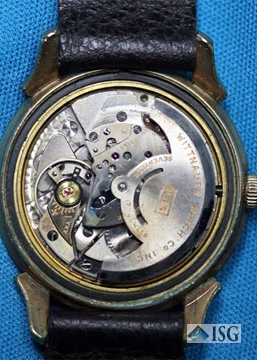 As seen at left, for many decades personal timekeeping was done by a watch utilizing a spring-loaded mechanical movement. The creation of these watches required as much artistry as mechanical expertise. Creating parts that would all work together to make a staff turn and, therefore, move the watch hands at exactly one second or one-minute intervals was a daunting task. Since, for the most part, watch movements marked time one second at a time, any deviation from the perfect calibration of the movement would result in a watch running too fast or too slow.
As seen at left, for many decades personal timekeeping was done by a watch utilizing a spring-loaded mechanical movement. The creation of these watches required as much artistry as mechanical expertise. Creating parts that would all work together to make a staff turn and, therefore, move the watch hands at exactly one second or one-minute intervals was a daunting task. Since, for the most part, watch movements marked time one second at a time, any deviation from the perfect calibration of the movement would result in a watch running too fast or too slow.
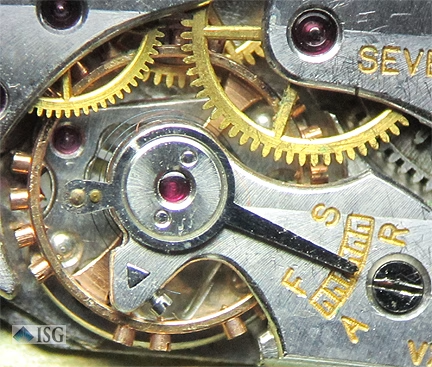 To calibrate the watch, the horologists (aka: watchmaker) would incorporate a calibration adjustment into the watch works as seen at left. The FA stands for Fast/Advance, and the SR stands for Slow/Retard. This allowed the watch to be calibrated, but it was extremely difficult to maintain perfect calibration since the watch had to be set so that one “Tik Tok” of the movement exactly equaled one second of time. Two more examples of calibration adjustments are seen below. On the right is just a + or – adjustment.
To calibrate the watch, the horologists (aka: watchmaker) would incorporate a calibration adjustment into the watch works as seen at left. The FA stands for Fast/Advance, and the SR stands for Slow/Retard. This allowed the watch to be calibrated, but it was extremely difficult to maintain perfect calibration since the watch had to be set so that one “Tik Tok” of the movement exactly equaled one second of time. Two more examples of calibration adjustments are seen below. On the right is just a + or – adjustment.
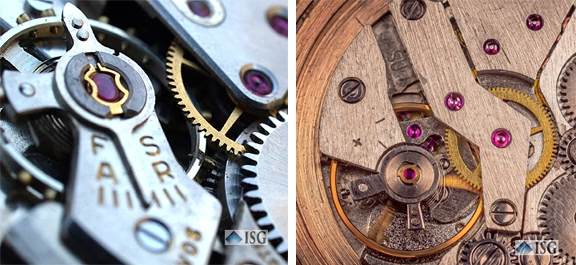
When a watch is accurately calibrated the hands will move perfectly at one-second intervals. The problem is that the mechanical movement basically moves at 1 time per second or one hertz. This leaves no room for variations in the calibration since the time interval is one “Tik Tok” must equal one second. A cheezy graphic demonstration is below. This is conceptual and not literal for the demonstration.
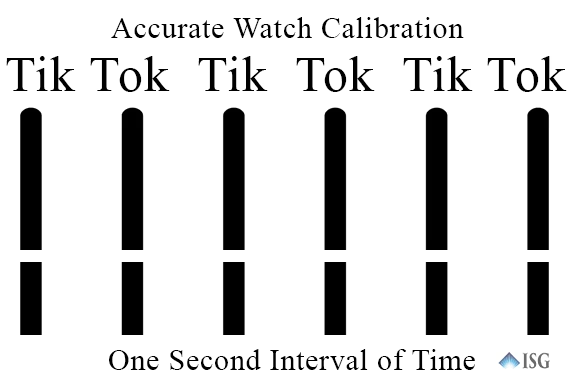
If the calibration is set too slow, the watch will run slow and not tell the accurate time.

#image_title
Likewise, if the watch calibration is too advanced, the watch will run fast. This is the problem with mechanical watches in general.
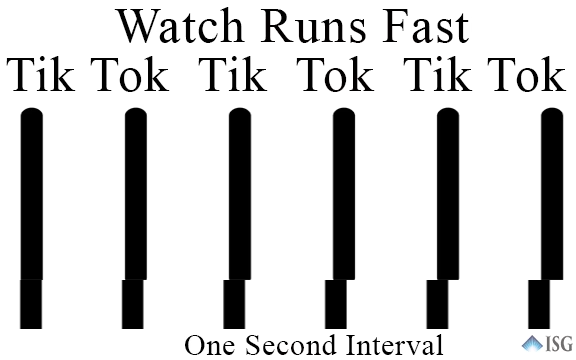
The calibration must be very accurate and that accuracy is difficult to maintain. But what if we can separate the seconds into 360 “Tik Tok” measurements?
In October of 1960, the Bulova Watch Company revolutionized the watch industry by introducing the Bulova Accutron. Based on battery-powered tuning fork technology, this tuning fork vibrates at 360 hertz, allowing for far more accurate timekeeping. Instead of matching up one “Tik Tok” per second, the Accutron could choose one of 360 “Tik Toks” per second. The ability to calibrate the watch became far more accurate, and electronic timekeeping became a reality.
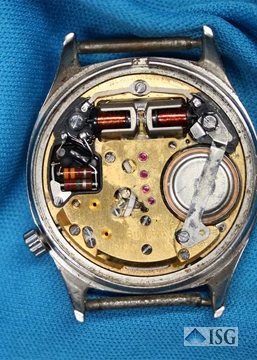
On the left is one of our Bulova Accutrons being used to develop our upcoming ISG Accredited Watch Professional Program.
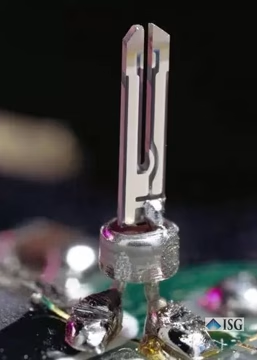 Just nine years later, the Seiko Watch Company replaced the tuning fork of the Bulova Accutron with a quartz crystal as seen at left. Astonishingly, the quartz crystal used in the Seiko quartz watch is basically the same shape as the tuning fork of the Accutron. However, the quartz crystal will vibrate at 32,768 hertz. Which means that quartz watch movement gets to choose from any one of 32,768 “Tik Toks” per second, allowing them to be by far the most accurate timekeeping watches. The watches were not only far more accurate but much smaller and less expensive. Which, in reality, makes them sort of boring but more on that later. Let us look at how all this stacks up in a single graphic.
Just nine years later, the Seiko Watch Company replaced the tuning fork of the Bulova Accutron with a quartz crystal as seen at left. Astonishingly, the quartz crystal used in the Seiko quartz watch is basically the same shape as the tuning fork of the Accutron. However, the quartz crystal will vibrate at 32,768 hertz. Which means that quartz watch movement gets to choose from any one of 32,768 “Tik Toks” per second, allowing them to be by far the most accurate timekeeping watches. The watches were not only far more accurate but much smaller and less expensive. Which, in reality, makes them sort of boring but more on that later. Let us look at how all this stacks up in a single graphic.
Based on our graphics above, here is how all three types of watches compare. You can see how the ability to calibrate the quartz watch makes timekeeping far more accurate.

This is obviously a simplified explanation of the full process involved. However, sometimes simple explanations serve the purpose of learning far better than a highly technical explanation that few will read.
This newsletter is a part of the ISG Accredited Watch Professional program being developed for launch in January 2025. Watches are an integral part of the jewelry industry and an essential study for jewelry appraisers. At the ISG, we care about your success.\
We welcome your comments, feedback, and suggestions. The ISG is a community and we welcome everyone to join in.
